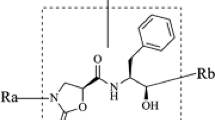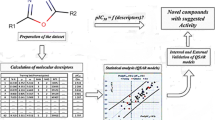Abstract
Fullerene and its derivatives have potential to be utilized in many biomedical applications. In the present study, we investigated the role of fullerene derivatives as inhibitors of HIV-RT by combined protein–ligand docking approach and QSAR methods. The study shows the best predictive QSAR model that represents a two-variable model. It has a good ratio of the number of descriptors and predictive ability. The main contributions to the inhibitory activity are provided by signal JhetZ descriptor and μ (dipole moment, as a measure of the polarity of a compound). The developed GA-MLRA-based model demonstrates a good performance, confirmed by statistics \(\left( {R^{2}_{\text{training}} = 0.867,\;Q^{2} = 0.788,\;R^{2}_{\text{test}} = 0.902} \right).\) The structure–activity analysis of these fullerene analogues allowed us to design and suggest for synthesis a set of new potentially active fullerenes. Finally, the molecular docking analysis was carried out to understand the details of interactions between HIV-RT and fullerene-C60 derivatives.







Similar content being viewed by others
References
Ahmed L, Rasulev B, Turabekova M, Leszczynska D, Leszczynski J (2013) Receptor and ligand-based study of fullerene analogues: comprehensive computational approach including quantum-chemical, QSAR and molecular docking simulations. Org Biomol Chem 11:5798–5808
Ardakani RB, Mirhosseini SM, Abadi FM (2014) Predicting critical micelle concentration by using stepwise—MLR and PLS as a variable selection mix method. Math Comput Chem 71:305–321
Boutorine AS, Tokuyama H, Takasugi M, Isobe H, Nakamura E, Helen C (1994) Fullerene-oligonucleotide conjugates: photo-induced sequence-specific DNA cleavage. Angew Chem Int Ed Engl 33:2462–2465
Cook SM, Aker WG, Rasulev BF, Hwang HM, Leszczynski J, Jenkins JJ, Shockley V (2010) Choosing safe dispersing media for C60 fullerenes by using cytotoxicity tests on the bacterium Escherichia coli. J Hazard Mater 176:367–373
Da Ros T, Prato M, Novello F, Maggini M, Banfi E (1996) Easy access to water-soluble fullerene derivatives via 1,3-dipolar cycloadditions of azomethine ylides to C60. J Org Chem 61:9070–9072
Datar PA (2014) 2D-QSAR study of indolylpyrimidines derivative as antibacterial against Pseudomonas aeruginosa and Staphylococcus aureus: a comparative approach. J Comput 10:1155–1164
De Oliveira DB, Gaudio AC (2003) BuildQSAR: a new computer program for QSAR analysis. Quant Struct Act Relat 19:599–604
Devillers J (1996) Genetic algorithms in molecular modeling. Academic Press, London
DRAGON 5.0 (2004) Evaluation version http://www.disat.unimib.it/chm
Dugan LL, Turetsky DM, Du C, Lobner D, Wheeler M, Almli CR, Shen CK, Luh TY, Choi DW, Lin TS (1997) Carboxyfullerenes as neuroprotective agents. Proc Natl Acad Sci 94:9434–9439
Durdagi S, Papadopoulos MG, Papahatjis DP, Mavromoustakos T (2008a) Computational design of novel fullerene analogues as potential HIV-1 PR inhibitors: analysis of the binding interactions between fullerene inhibitors and HIV-1 PR residues using 3D QSAR, molecular docking and molecular dynamics simulations. Bioorg Med Chem 16:9957–9974
Durdagi S, Mavromoustakos T, Papadopoulos MG (2008b) 3D QSAR CoMFA/CoMSIA, molecular docking and molecular dynamics studies of fullerene-based HIV-1 PR inhibitors. Bioorg Med Chem Lett 23:6283–6289
Ewing TJ, Makino S, Skillman AG, Kuntz ID (2001) DOCK 4.0: search strategies for automated molecular docking of flexible molecule databases. J Comput Aided Mol Des 15:411–428
Fourches D, Pu D, Tassa C, Weissleder R, Shaw SY, Mumper RJ, Tropsha A (2010) Quantitative nanostructure—activity relationship modeling. ACS Nano 4:5703–5712
Friedman SH, DeCamp DL, Sijbesma RP, Srdanov G, Wudl F, Kenyon GL (1993) Inhibition of the HIV-1 protease by fullerene derivatives: model building studies and experimental verification. J Chem Soc 115:6506–6509
Frisch MJ et al. (2009) Gaussian 09, revision B.01. Wallingford CT
Hansch C, Leo A (1995) Exploring QSAR, hydrophobic, electronic and steric constants. ACS, Washington, DC
Hansch C, Leo A, Hoekman DH (1995) Exploring QSAR, fundamentals and application in chemistry and biology. ACS, Washington, DC
Helguera AM, Comnbbbes RD, González MP, Cordeiro MN (2008) Applications of 2D descriptors in drug design: a DRAGON tale. Curr Top Med Chem 28:1628–1655
Huang YL, Shen CK, Luh TY, Yang HC, Hwang KC, Chou CK (1998) Blockage of apoptotic signaling of transforming growth factor- in human hepatoma cells by carboxyfullerene. Eur J Biochem 254:38–43
Huey R, Morris GM, Olson AJ, Goodsell DS (2007) A semiempirical free energy force field with charge-based desolvation. J Comput Chem 28:1145–1152
Hyperchem (hypercube) homepage. (2009) http://www.hyper.com
Jin H, Chen WQ, Tang XW, Chiang LY, Yang CY, Schloss JV, Wu JY (2000) Polyhydroxylated C60, fullerenols, as glutamate receptor antagonists and neuroprotective agents. J Neurosci Res 62:600–607
Jones G, Willett P, Glen RC, Leach AR, Taylor R (1997) Development and validation of a genetic algorithm for flexible docking. J Mol Biol 267:727–748
Kim JE, Lee MT (2003) Fullerene inhibits 3-amyloid peptide aggregation. Biochem Biophys Res Commun. 303:576–579
Manoel AM, Filho José Diogo LD, Gerd BR, Ricardo OF, Alfredo MS (2013) Sparkle/RM1 parameters for the semiempirical quantum chemical calculation of lanthanide complexes. RSC Adv 3:16747–16755
Marcorin GL, Da Ros T, Castellano S, Stefancich G, Bonin I, Miertus S, Prato M (2000) Design and synthesis of novel fullerene derivatives as potential HIV aspartic protease inhibitors. Org Lett 2:3955–3958
Mashino T, Shimotohno K, Ikegami N, Nishikawa D, Okuda K, Takahashi K, Nakamura S, Mochizuki M (2005) Human immunodeficiency virus-reverse transcriptase inhibition and hepatitis C virus RNA-dependent RNA polymerase inhibition activities of fullerene derivatives. Bioorg Med Chem Lett 15:1107–1109
Morris GM, Goodsell DS, Halliday RS, Huey R, Hart WE et al (1999) Automated docking using a Lamarckian genetic algorithm and an empirical binding free energy function. J Comput Chem 19:1639–1662
Morris GM, Huey R, Lindstrom W, Sanner MF, Belew RK, Goodsell DS, Olson AJ (2009) Autodock4 and AutoDockTools4: automated docking with selective receptor flexibility. J Comput Chem 16:2785–2791
Nakamura S, Mashino T (2009) Biological activities of water soluble fullerene derivatives. J Phys 159:1742–6596
Ojha PK, Mitra I, Das RN, Roy K (2011) Further exploring rm2 metrics for validation of QSPR models. Chemom Intell Lab Syst 107:194–205
Park KH, Chhowalla M, Iqbal Z, Sesti F (2003) Single-walled carbon nanotubes are a new class of ion channel blockers. J Biol Chem 278:50212–50216
Petrova T, Rasulev B, Toropov A, Leszczynska D, Leszczynski J (2011) Improved model for fullerene C60 solubility in organic solvents based on quantum-chemical and topological descriptors. J Nanopart Res 13:1–13
Puzyn T, Leszczynski J, Cronin MTD (2010) Recent advances in QSAR studies. Springer, New York
Rarey M, Kramer B, Lengauer T, Klebe G (1996) A fast flexible docking method using an incremental construction algorithm. J Mol Biol 261:470–489
Rasulev BF, Saidkhodzhaev AI, Nazrullaev SS, Akhmedkhodzhaeva KS, Khushbaktova ZA, Leszczynski J (2007) Molecular modelling and QSAR analysis of the estrogenic activity of terpenoids isolated from Ferula plants. SAR QSAR Environ Res 18:663–673
Roy K, Mitra I, Kar S, Ojha PK, Das RN, Kabir H (2012) Comparative studies on some metrics for external validation of QSPR models. J Chem Inf Model 52:396–408
Schuster DI, Wilson SR, Schinazi RF (1996) Anti-human immunodeficiency virus activity and cytotoxicity of derivatized buckminster fullerenes. Bioorg Med Chem Lett 6:1253–1256
Selvaraj C, Tripathi SK, Reddy K, Singh SK (2011) Tool development for prediction of pIC50 values from the IC50 values—a pIC50 value calculator. Curr Trends Biotechnol Pharm 5:1104–1109
Sijbesma R, Srdanov G, Wudl F, Castoro JA, Wilkins C, Friedman SH, DeCampDL Kenyon GL (1993) Synthesis of a fullerene derivative for the inhibition of HIV enzymes. J Am Chem Soc 115:6510–6512
Tkach AV, Yanamala N, Stanley S, Shurin MR, Shurin GV, Kisin ER, Murray AR, Pareso S, Khaliullin T, Kotchey GP, Castranova V, Mathur S, Fadeel B, Star A, Kagan VE, Shvedova AA (2013) Graphene oxide, but not fullerenes, targets immunoproteasomes and suppresses antigen presentation by dendritic cells. Small 9:1686–1690
Todeschini R, Consonni V (2000) Handbook of molecular descriptors. Wiley, Weinheim
Todeschini R, Consonni V, (2003) DRAGON software for the calculation of molecular descriptors., web version 3.0 for Windows
Toropov AA, Rasulev B, Leszczynska D, Leszczynski J (2007) Additive SMILES based optimal descriptors: QSPR modeling of fullerene C60 solubility in organic solvents. Chem Phys Lett 444:209–214
Toropov A, Rasulev B, Leszczynska D, Leszczynski J (2008) New approach to QSPR modeling of fullerene C60 solubility in organic solvents: an application of SMILES-based optimal descriptors. Med Chem Pharmacol Potential Fuller Carbon Nanotub 1:337–350
Trott O, Olson AJ (2010) AutoDock Vina: improving the speed and accuracy of docking with a new scoring function, efficient optimization and multithreading. J Comput Chem 31:455–461
Yilmaz H, Güzel Y, Önal Z, Altıparmak G, Özhan KŞ (2012) 4D-QSAR study of P56lck protein tyrosine kinase inhibitory activity of flavonoid derivatives using MCET method. J Bull Korean Chem Soc 32:4352–4360
Yilmaz H, Güzel Y, Boz M, Türkmenoğlu B (2014) Pharmacophore and functional group identification of 4,4′-dihydroxydiphenylmethane as bisphenol-A (BSA) derivatives. Trop J Pharma Res 13:117–129
Yilmaz H, Rasulev B, Leszczynski J (2015) Modeling the dispersibility of single walled carbon nanotubes in organic solvents by quantitative structure-activity relationship approach. Nanomaterials 5:778–791
Zhao Y, Truhlar DG (2008) The M06 suite of density functionals for main group thermochemistry, kinetics, noncovalent interactions, excited states, and transition elements: two new functionals and systematic testing of four M06 functionals and twelve other functionals. Theor Chem Acc 120:215–241
Acknowledgments
This work was financially supported by The Scientific and Technological Research Council of Turkey (TÜBİTAK) and by NSF CREST Interdisciplinary Nanotoxicity Center NSF-CREST—Grant # HRD-0833178. The authors also thank the Extreme Science and Engineering Discovery Environment (XSEDE) for the award allocations (TG-DMR110088 and CHE140005) and the Mississippi Center for Supercomputer Research (Oxford, MS) for a generous allotment of a computer time. B.R. gratefully acknowledges support from the North Dakota State University Center for Computationally Assisted Science and Technology and the U.S. Department of Energy through Grant No. DE-SC0001717.
Author information
Authors and Affiliations
Corresponding author
Ethics declarations
Conflict of interest
The authors declare no conflict of interest.
Electronic supplementary material
Below is the link to the electronic supplementary material.
Rights and permissions
About this article
Cite this article
Yilmaz, H., Ahmed, L., Rasulev, B. et al. Application of ligand- and receptor-based approaches for prediction of the HIV-RT inhibitory activity of fullerene derivatives. J Nanopart Res 18, 123 (2016). https://doi.org/10.1007/s11051-016-3429-7
Received:
Accepted:
Published:
DOI: https://doi.org/10.1007/s11051-016-3429-7




